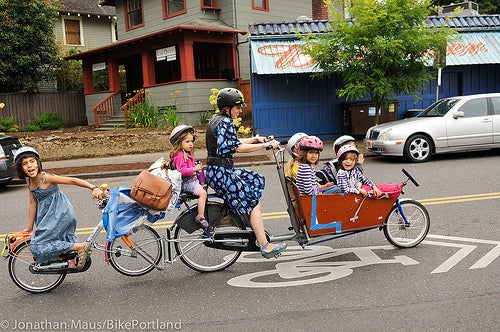
It’s that time of the year again. Time to buy the kids new shoes, despair over what to pack in the lunch box, and fantasize about a different kind of future, one in which more children in more towns across the country are able to ride their bikes to school.
Well, make that more people riding bikes, period.
On pretty much every level—from rising obesity levels and carbon emissions to dwindling energy reserves—cycling just makes sense. According to the non-profit advocacy group People for Bikes, for every mile you pedal instead of drive, you cut one pound of carbon dioxide pollution, and three hours of riding per week reduces your risk of heart disease and stroke by half. Adolescents who ride are 48 percent less likely to become overweight as adults. Cycling’s good for our health, and the health of our planet. But to make it possible on a large scale, we need bike-friendly infrastructure. And that takes money, will, and major vision. That'll take a bike revolution.
The good news is that more people are riding and want to ride. Cycling rose in New York City by 26 percent in a single year, 2008-09. The nation’s 38 “Bicycle Friendly Communities” (Boulder, Davis, and Portland win top honors; check out for the complete list) saw a 95 percent average increase in bike commuting. A recent national survey by the National Highway Traffic Safety Administration found that 71 percent of Americans say they would like to bicycle more than they do now. According to People for Bikes, 47 percent of Americans say they would like to see more bike lanes, trails, and bridges in their towns. Cities like Washington, D.C., Minneapolis/St. Paul, Boston, and Chattanooga have introduced urban bike share programs, and similar initiatives are in the works in New York (now delayed 'til next spring), San Francisco, and Chicago. And model bike-friendly communities, including Davis, with its pancake-flat web of bike trails and lanes, supports student riders with cool programs that encourage kids to ride to school and log their miles.
The bad news: Funding to support bike-friendly infrastructure is being cut. On June 29, Congress and President Obama signed a new transportation bill that, when it goes into effect on October 1, will eliminate all dedicated funding for local safety projects that support biking and walking, including the Safe Routes to School program. Governors in a dozen states are also now allowed to opt out of receiving funding for recreational trails like rail trails and singletrack.
What can you do? Support advocacy groups like the , , and , a coalition of bicycle industry members that’s working locally and federally to get more riders on bikes more often. At peopleforbikes.org, use their online form to send a letter to your state governor asking him or her to allow for recreational trail funding in your state. Take the group’s free online pledge to support cycling in all its forms: commuting, cruising, racing, riding around the block. Check out promising initiatives happening around the country, from new singletrack in the Black Hills of South Dakota and “bike trains” that help school kids commute on two wheels to new connector trails in Virginia and Hollywood’s first bike lanes. Learn where your state and city are ranked by the and get tips for advocating on behalf of bicycles in your home district. And encourage your kid's school to develop bike-to-school programs. In conjunction with Safe Routes to School, energy-bar maker CLIF Kids has developed a toolkit to help schools and parents host a successful Walk and Bike to School Day in October, reflective stickers for bikes and helmets, event signage for schools, and CLIF goodies for participating students.
But perhaps nothing's more inspiring than tales of real-life “transportation transformations,” the most dramatic of which is that of Emily Finch. The Portland, Oregon, mother of six traded in her Suburban for a bakfiets, a Dutch cargo bike that looks like a cross between a town bike and a wheelbarrow and fits her whole brood (ages two to 11) and groceries. Note to self: Think about that the next time you complain about lugging two little ones in a trailer. In a word, wow. (Read the full story at �ǰ���.)
Here’s to a future where more communities support more cyclists of all ages. Isn't that an idea we can all get behind?
—Katie Arnold